Motor vehicle
| Chevrolet Express GMC Savana | |
|---|---|
 2005 Chevrolet Express | |
| Overview | |
| Manufacturer | General Motors |
| Also called |
|
| Production | 1995–present |
| Model years | 1996–present |
| Assembly | United States: Wentzville, Missouri (Wentzville Assembly) Springfield, Ohio (Navistar) |
| Body and chassis | |
| Class | Full-size van |
| Body style | 2-door cutaway van chassis 4-door cargo van 4-door passenger van 5-door cargo van 5-door passenger van |
| Layout | Front engine, rear wheel drive all-wheel drive (2003–2014) |
| Platform | GMT600 (1996–2002) GMT610 (2003–present) |
| Chassis | Body-on-frame (ladder); boxed frame rails |
| Related | Chevrolet C/K (GMT400) Chevrolet Silverado (GMT800) Chevrolet Kodiak/GMC TopKick (GMT560) |
| Powertrain | |
| Engine | GMT600
|
| Transmission | GMT600
|
| Dimensions | |
| Wheelbase |
|
| Length | GMT600
|
| Width | GMT600
|
| Height | GMT600
|
| Chronology | |
| Predecessor | Chevrolet Van/Beauville GMC Vandura/Rally |
The Chevrolet Express (also known as the GMC Savana) is a range of full-size vans from General Motors. The successor of the Chevrolet Van, a single generation of the model line has been sold since the 1996 model year. The model line is sold in three major versions, including a passenger van, cargo van, and a cutaway van chassis; the latter vehicle is a chassis cab variant developed for commercial-grade applications, including ambulances, buses, and small trucks. Marketed primarily in North America, the model line competes with the Ford Transit and Ford E-Series (dependent on configuration), Mercedes-Benz/Freightliner Sprinter, and the Ram ProMaster (cargo van only).
For 2022 production, the model line enters its 26th year of production, serving as one of the longest-produced automotive designs in American automotive history. Since 1995, General Motors has assembled the Express and Savana at its Wentzville Assembly facility (Wentzville, Missouri). Since 2017, production of the model line has also been sourced from Navistar International through its Springfield, Ohio assembly plant.[1] [2]
Model history [edit]
1996–2002 [edit]

1996–2002 Chevrolet Express 3500 LS
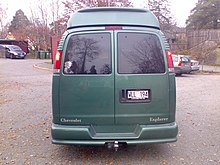
Rear view, showing taillamps (1998 Chevrolet Express 1500 conversion van)
For the 1996 model year, Chevrolet replaced the G-series Chevrolet Van with the Chevrolet Express (retaining Chevrolet Van for cargo vans). The first all-new design for the General Motors full-size van line since 1971, the model line was offered in passenger and cargo-van variants (the latter initially retained the Chevrolet Van name), with GMC replacing the Vandura/Rally with the Savana.[3] Alongside the first substantial redesign of the model line in 25 years, GM predicted substantial growth in the full-size segment through the end of the 1990s.[3]
In a major functional change, the front axle was moved forward 10 inches, effectively moving the front wheels out of the passenger compartment; along with improving front legroom, the design allowed a reduction in step-in height (improving access).[4] While sharing the same engines as the previous model line, the size of the engine cover was reduced, further increasing front passenger space.[4] On all vehicles below 8500 lbs GVWR (1500 and 2500 series), the Express was introduced with standard dual airbags; for 1997, dual airbags were standardized for all versions of the model line.[4] [5]
For 1999, few minor functional changes were made to the model line. In a more noticeable update, Chevrolet retired the Chevrolet Van nameplate entirely, with the cargo van renamed the Express Cargo Van.[5]
2003–present [edit]
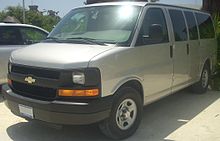
2006–2010 Chevrolet Express (with left-side passenger doors)
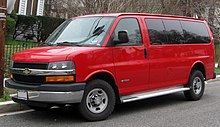
2011–2012 Chevrolet Express 3500
For 2003, the Express underwent a mid-cycle revision. Alongside substantial frame and chassis upgrades, the bodywork forward of the windshield was revised.[5] Distinguished by a higher hoodline, the newer front fascia (developed as an improved crumple zone[5]) was brought closer in line with the GMT800 full-size pickup trucks introduced for 1999; the model line also introduced a degree of parts commonality between the two model lines.[5] The dashboard underwent a redesign; along with the addition of dual-stage airbags, the interior added multiplex wiring (adding increased functionality to the interior electrical system).[6] [7]
In a first (since the Corvair cargo van), the Express was offered with optional 60/40 panel doors on both sides of the vehicle; the option was limited to the standard-length body (requiring doors on both sides).[6] After the 2008 model year, the configuration was discontinued.[ citation needed ]
Since its 2003 model revision, the Express has seen incremental updates to the model line. For 2008, the Express passenger van received side-curtain airbags and standard stability control (introduced for 3500-series vans for 2005[8]); the steering wheel was also redesigned.[9] For 2011, the dashboard received upgrades (including Bluetooth compatibility and a USB port).[10] For 2013, higher-trim passenger vans received a optional navigation system, rearview camera, and parking assist system.[11] For 2015, all radios became digitally-tuned and a 120-volt outlet was added to the dash.[12] For 2018, the Express dropped sealed-beam headlights from all models, adopting the four composite headlamps of higher-trim passenger vans.[13] For 2019, higher-trim passenger vans received lane departure warning systems and collision alert warning features.[14]
Entering its 25th year of production for the 2021 model year, the Chevrolet Express matched the third-generation G-series Chevrolet Van in model longevity.
For 2022, the optional CD player was discontinued.[2]
Model overview [edit]
Chassis [edit]
The Chevrolet Express uses the GM GMT600 chassis, developed exclusively for full-size vans. Derived loosely from the GMT400 chassis of the fourth-generation C/K trucks, the model line uses a full-length ladder frame with boxed forward frame rails.[3] [4] The GMT600 was offered in two wheelbases, a standard 135-inch length and an extended 155-inch length (created by moving the front axle 10 inches forward on both versions[4]).[3] The short-wheelbase 110-inch chassis was not replaced, as it functionally overlapped the Chevrolet Astro/GMC Safari mid-size van.
For 2003, the GMT600 chassis underwent a substantial revision and was redesignated GMT610. In line with the GMT800 chassis, the GMT610 adopted a three-section fully-boxed frame.[15] With slight modifications, the GMT610 also adopted the front suspension of the GMT800 pickup trucks, with short-long arm front suspension (rear-wheel drive) and torsion-bar front springs (all-wheel drive).[6] In another change, four-wheel disc brakes were introduced, standardizing anti-lock brakes (ABS).[15] In a first for the full-size van segment, the GMT610 platform was also offered with full-time all-wheel drive as an option.[15] [6]
Powertrain details [edit]
At its launch, the Chevrolet Express was introduced with five engines. Shared with C/K pickup trucks, a 4.3L V6 was standard, with 5.0L, 5.7L, 6.5L turbodiesel and 7.4L V8s were options.[3] All gasoline engines adopted the "Vortec" port-fuel injection upgrades for 1996, increasing power and torque outputs; the 6.5L turbodiesel was offered in a full-size van for the first time. All engines were paired with a 4-speed overdrive automatic, carried over from the Chevrolet Van; 1500-series vehicles used a 4L60E transmission while 2500 and 3500-series vehicles used a heavier-duty 4L80E unit.
For 2001, the Vortec 7400 was replaced by the longer-stroke Vortec 8100 (at 496 cubic inches, this is the largest-displacement engine ever factory-marketed by Chevrolet); the engine was offered for the Express through 2002.
For 2003, the engine lineup underwent a series of revisions, retaining only the 4.3L V6 from 2002. The "Generation III" small-block V8 engines (based on the LS-series engines) were introduced, with the Express receiving 4.8L, 5.3L, and 6.0L V8s.[6]
For 2006, a diesel engine offering returned, adopting a detuned version of the 6.6L Duramax V8 from the Chevrolet Kodiak. For 2008, 5.3L V8s on 1500-series vans gained flex-fuel (E85) capability.
For 2010, 2500 and 3500-series vans used the six speed 6L90 transmission.
Coinciding with the discontinuation of the 1500-series, the Vortec 4300 V6 (the final engine derived from the original Chevrolet small-block V8) was discontinued in 2014.
After 2016, the 6.6L Duramax diesel V8 was discontinued; a 2.8L inline-4 Duramax (the first four-cylinder in a full-size Chevrolet van since 1964) replaced it as the diesel engine offering. For 2018, an "EcoTec3" 4.3L V6 was introduced as the base gasoline engine (sharing little more than its displacement with the Vortec 4300); the same year, CNG/LPG capability was added as an option to the 6.0L V8.
For 2021, the 6.0L V8 was replaced by an all-new 6.6L V8.[16]
The 1500 series either has a 3.42 or 3.73 axle. The 2500 and 3500 series van will have a 3.73 axle or 4.10 axle.
Body design [edit]
Far more aerodynamic than its predecessor, the Chevrolet Express derived much of exterior styling from the Chevrolet Astro mid-size van (including its flush-mounted exterior glass[4]), deriving its grille from multiple trims of the Chevrolet C/K pickup trucks.[3] Similar to the APV minivans, the Express adopted high-mounted taillamps (besides the rear windows); the design was out of necessity, as the rear door hinges are located below the taillamps. To aid in rear cargo loading, the rear doors are hinged to open nearly 180 degrees, allowing the vehicle to back up to a loading dock.[3] [4]
The cargo van is offered as a two-passenger vehicle (with an optional passenger seat delete); the passenger van is offered as a 5, 8, 12, or 15-passenger vehicle (the latter, only with the extended 155-inch wheelbase).[3] [13] [6] In reverse of the G-series van, 60/40 split side doors were standard, with a sliding door offered as an option (initially at no cost).[13]
Trim [edit]
For its 1996 launch, Chevrolet used the Chevrolet Express model name for full-size passenger vans, with Chevrolet Van returning for cargo vans (renamed Express Cargo Van for 1999[5]).[3] [4]
The Express passenger van was introduced with two trim lines: an unnamed base trim (geared largely towards fleet sales) replacing the Sportvan and the upgraded LS, replacing the Beauville.[4] For 2001, an upgraded LT trim was introduced, but was dropped for 2003.[17] For 2006, the trim line was revised again to the current nomenclature, with the base trim renamed LS, and LS renamed LT.[18]
In line with the previous Chevrolet Van, the Express uses "G" as its internal model designator ("H" was used for all-wheel drive vans during their production). However, the model line adopted the 1500/2500/3500 payload series used by GM full-size pickup trucks. After the 2014 model year, the 1⁄2 -ton 1500-series was permanently discontinued (with GM citing it as the lowest-selling version[19]).[20]
Variants [edit]
GMC Savana [edit]

GMC Savana 1500 conversion van (1996–2002)

The Chevrolet Express is sold by the GMC division as the GMC Savana, replacing the GMC Vandura and GMC Rally cargo and passenger vans, respectively; the Savana is also sold in a cutaway chassis for commercial applications (see below).
As of current production, the Savana is outsold by the Express approximately three-to-one.[21] With the exception of the grille and divisional badging, the two models are largely identical.
In contrast to the rest of the GMC model line, the Savana has is not sold with upscale Denali trim (the Savana shares its LS and LT trims with Chevrolet).
GMT560 [edit]
For 2003, General Motors introduced the GMT560 medium-duty truck architecture for Chevrolet, GMC, and Isuzu. In place of the GM pickup-truck cab, General Motors adopted the vertically-oriented cab from the Express/Savana full-size vans. Alongside a two-door configuration, the GMT560 vehicles were offered as a four-door crew cab.
Produced as a Class 5-7 truck, the GMT560 vehicles (the Chevrolet Kodiak, GMC TopKick, and Isuzu H-Series) were offered in 4x2, 4x4, and 6x4 drive for multiple applications.
After 2009, General Motors ended medium-duty truck production, leading to the discontinuation of the GMT560 chassis.
Cutaway chassis [edit]
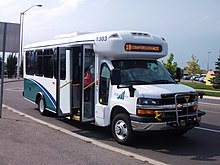
Chevrolet Express G4500 cutaway chassis with low-floor bus body
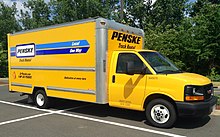
GMC Savana G3500 with moving truck body (Penske)
Produced primarily for commercial use, cutaway-cab chassis are incomplete vehicles (a chassis produced with no bodywork aft of the front seats) intended for completion by a second-party manufacturer. The additional bodywork is developed specifically for the chassis and can suit a wide range of potential applications. Best known for ambulances, buses (shuttle buses and school buses), and recreational vehicles (RVs), cutaway chassis are also fitted with delivery truck bodies or utility bodies (increasing their storage space over a standard cargo van).
Offered through both the Chevrolet Express and GMC Savana, the cutaway chassis is offered on the 3500 series in both dual rear-wheel and single-rear wheel configurations (the latter, trading lower GVWR for increased maneuverability). For 2009 production, GM introduced a 4500-series Express/Savana specifically for cutaway use, raising its GVWR to 14,200 pounds.[22] [23]
Other uses of nameplate [edit]
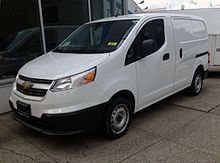
2015 Chevrolet City Express LS cargo van (Nissan NV200)
Chevrolet used the Express nameplate for the first time on a 1987 concept car designed for future limited-access highways.[24] The vehicle was turbine-powered with drive-by-wire controls.[24]
The Chevrolet City Express cargo van was offered from 2014 to 2018, derived from the Nissan NV200 small MPV.
References [edit]
- ^ "2021 Chevy Express Rumors, Redesign, Price". Chevy Car USA. July 16, 2019. Retrieved January 2, 2021.
- ^ a b "2022 Chevy Express And GMC Savana To Drop CD Player Option". GM Authority . Retrieved July 1, 2021.
- ^ a b c d e f g h i "1996 Chevrolet Express Full-Size Van First Drive Review". MotorTrend. May 25, 2020. Retrieved January 4, 2021.
- ^ a b c d e f g h i "Chevrolet Trucks Specifications | 1996 Chevrolet G-Vans" (PDF). GM Heritage Archive | Vehicle Information Kits (1996 Chevrolet G Van).
- ^ a b c d e f "1999 Chevrolet G-Van: Express, Cargo, and Cutaway" (PDF). GM Heritage Center | Vehicle Information Kits (1999 Chevrolet G-Vans).
- ^ a b c d e f "2003 Chevrolet Express and GMC Savana". Motor Trend. November 8, 2002.
- ^ "2003 Chevrolet Express Cargo Review & Ratings". Edmunds.
- ^ "2005 Chevrolet Express Review & Ratings". Edmunds . Retrieved June 10, 2021.
- ^ "2008 Chevrolet Express Review & Ratings". Edmunds . Retrieved June 10, 2021.
- ^ "2011 Chevrolet Express Review & Ratings". Edmunds . Retrieved June 10, 2021.
- ^ "2013 Chevrolet Express Review & Ratings". Edmunds . Retrieved June 10, 2021.
- ^ "2015 Chevrolet Express Review & Ratings". Edmunds . Retrieved June 10, 2021.
- ^ a b c "2018 Savana Passenger Van". www.gmc.com . Retrieved July 25, 2018.
- ^ "Used 2019 Chevrolet Express for Sale Near Me". Edmunds . Retrieved June 10, 2021.
- ^ a b c Swan, Tony (April 1, 2003). "Tested: 2003 Chevy Express AWD". Car and Driver . Retrieved January 4, 2021.
- ^ "2021 Chevrolet Express Receives New 6.6L V8 Gas Engine". GM Authority. March 3, 2020.
- ^ "2001 Chevrolet Express Review & Ratings". Edmunds . Retrieved June 10, 2021.
- ^ "2006 Chevrolet Express Review & Ratings". Edmunds . Retrieved June 10, 2021.
- ^ "Chevy Express 1500, GMC Savana 1500 get the axe". Autoblog.com. July 15, 2014. Retrieved December 15, 2015.
- ^ "Chevrolet Express 1500, GMC Savana 1500 Dropped From Lineup for 2015". Edmunds. July 24, 2014. Retrieved January 5, 2021.
- ^ "GMC Savana". GM Authority . Retrieved January 4, 2021.
- ^ "StackPath". www.trailer-bodybuilders.com . Retrieved January 5, 2021.
- ^ "2009 Chevrolet Express And GMC Savana 4500 Cutaway Van - First Look". Truck Trend. February 29, 2008. Retrieved January 5, 2021.
- ^ a b "1987 Chevrolet Express Images, Information and History". Conceptcarz.com. Retrieved May 22, 2010.
External links [edit]
- Official Chevrolet Site for Express
- Official GMC Site for Savana
Posted by: marcusbolioe06809.blogspot.com
Source: https://en.wikipedia.org/wiki/Chevrolet_Express